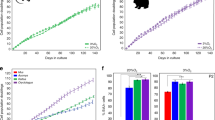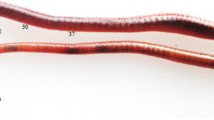Abstract
Fibroblast cycle synchronization in G0/G1 is an essential step for nuclear reprogramming by cloning or induced cells to pluripotency. Considering the diversity among rodents and the ecological and scientific importance of these animals, we compared the contact inhibition, serum starvation, and 10 µM of roscovitine as methods of synchronization of red-rumped agouti fibroblasts. The effects of each protocol were evaluated on the percentage of cycle phase, morphology, viability, and apoptosis levels. The results showed that culturing the cells to serum starvation for 24 h (75.9%), 48 h (81.6%), 72 h (86.2%), 96 h (84.0%), and 120 h (83.7%) yielded a significantly higher percentage of cells arrested in the G0/G1 (P < 0.05) phase than cells not subjected to any cell cycle synchronization method (31.4%). Also, this effect was not different between the times of 48 and 120 h (P > 0.05). A similar response was observed for cells cultured with roscovitine for 12 h (86.9%), 24 h (74.8%), and 48 h (81.7%), with a higher percentage of synchronized cells in G0/G1 compared to cells not submitted to any synchronization treatment (52.2%). Nevertheless, this effect was best evidenced at 12 h (P < 0.05). Also, the contact inhibition for 24–120 h could not synchronize cells in G0/G1, with values ranging from 70.9 to 77.9% (P > 0.05). Moreover, no difference was observed for morphology, viability, and apoptosis levels in any synchronization method (P > 0.05). Therefore, serum starvation is as efficient as roscovitine on cycle synchronization in G0/G1 of red-rumped agouti fibroblasts.





Similar content being viewed by others
Data availability
Data may be made available upon reasonable request to the corresponding author.
References
Akshey Y, Malakar D, De AK, Jena MK, Pawar SK, Dutta R, Sahu S (2011) Effect of roscovitine treated donor cells and different activation methods on development of handmade cloned goat (Capra hircus) embryos. Theriogenology 75:1516–1524. https://doi.org/10.1016/j.theriogenology.2010.12.015
Borges AA, Luciano MCS, Nascimento MB, Lira GPO, Oliveira FCE, Pessoa C, Pereira AF (2021) Effects of incubation time and method of cell cycle synchronization on collared peccary skin-derived fibroblast cell lines. Ann Anim Sci 21:925–938. https://doi.org/10.2478/aoas-2020-0103
Caamaño JN, Rodriguez A, Salas A, Munoz M, Diez C, Prather RS, Gomez E (2008) Flow cytometric cell cycle analysis of cultured brown bear fibroblast cells. Cell Biol Int 32:855–859. https://doi.org/10.1016/j.cellbi.2008.02.005
Campos LB, Peixoto GC, Lima GL, Castelo TS, Souza AL, Oliveira MF, Silva AR (2015) Monitoring of the estrous cycle of agoutis (Dasyprocta leporina Lichtenstein, 1823) by vaginal exfoliative cytology and ultrasonography. Pesqui Vet Bras 35:188–192. https://doi.org/10.1590/S0100-736X2015000200016
Chen Q, Zhu C, Li X, Kou Y, Zhao R, Li L, Xu L, Yang L, Yang H, Gu X, Wang C, Liu C, Jiang SG (2020) Chromatin architecture reorganization in murine somatic cell nuclear transfer embryos. Nat Commun 11:1–14. https://doi.org/10.1038/s41467-020-15607-z
Costa CA, Borges AA, Nascimento MB, Aquino LVC, Silva AR, Oliveira MF, Pereira AF (2020) Effects of vitrification techniques on the somatic tissue preservation of agouti (Dasyprocta leporina Linnaeus, 1758). Biopreserv Biobank 18:165–170. https://doi.org/10.1089/bio.2019.0109
Dantas MR, Silva AM, Bezerra LG, Pereira AG, Luz NR, Souza-Junior JB, Oliveira MF, Silva AR (2022) Morphological, morphometric, ultrastructural, and functional evaluation of red-rumped agouti (Dasyprocta leporina) sperm during epididymal transit. Anim Reprod Sci 243:107029. https://doi.org/10.1016/j.anireprosci.2022.107029
Emmons L, Reid F (2016) Dasyprocta leporina. The IUCN Red List of Threatened Species. https://doi.org/10.2305/IUCN.UK.2016-2.RLTS.T89497102A22197762.en
Gibbons J, Arat S, Rzucidlo J, Miyoshi K, Waltenburg R, Respess D, Venable A, Stice S (2002) Enhanced survivability of cloned calves derived from roscovitine-treated adult somatic cells. Biol Reprod 66:895–900. https://doi.org/10.1095/biolreprod66.4.895
Gouveia C, Huyser C, Egli D, Pepper (2020) Lessons learned from somatic cell nuclear transfer. Int J Mol Sci 21:2314. https://doi.org/10.3390/ijms21072314
Herrick JR (2019) Assisted reproductive technologies for endangered species conservation: developing sophisticated protocols with limited access to animals with unique reproductive mechanisms. Biol Reprod 100:1158–1170. https://doi.org/10.1093/biolre/ioz025
Jiang JY, Mizuno S, Mizutani E, Miyoshi K, Kimura N, Sasada H, Sato E (2002) Nuclear transfer in rats using an established embryonic cell line and cumulus cells. J Reprod Dev 48:505–511. https://doi.org/10.1262/jrd.48.505
Kaiser SK, Margarido TCC, Fischer ML (2011) Behavioral evaluation of captive and semi-captive agoutis Dasyprocta azarae and Dasyprocta leporina (Rodentia: Dasyprotidae), on urban parks of Curitiba, Paraná, Brazil. Rev Etol 10:68–82
Kato Y, Akiko Y, Nami M, Jun-ya K, Yukio T (1999) Developmental potential of mouse follicular epithelial cells and cumulus cells after nuclear transfer. Biol Reprod 61:1110–1114. https://doi.org/10.1095/biolreprod61.4.1110
Ligasová A, Koberna K (2021) Strengths and weaknesses of cell synchronization protocols based on inhibition of DNA synthesis. Int J Mol Sci 22:10759. https://doi.org/10.3390/ijms221910759
Mittelman P, Dracxler CM, Santos-Coutinho PR, Pires AS (2021) Sowing forests: a synthesis of seed dispersal and predation by agoutis and their influence on plant communities. Biol Rev 96:2425–2445. https://doi.org/10.1111/brv.12761
Młodawska W, Mrowiec P, Bochenek M, Wnęk K, Kochan J, Nowak A, Niżański W, Prochowska S, Pałys M (2022) Effect of serum starvation and contact inhibition on dermal fibroblast cell cycle synchronization in two species of wild felids and domestic cat. Ann Anim Sci 22:1245–1255. https://doi.org/10.2478/aoas-2022-0042
Mrowiec P, Bugno-Poniewierska M (2022) Technical, biological, and molecular aspects of somatic cell nuclear transfer–a review. Ann Anim Sci 22:63–87. https://doi.org/10.2478/aoas-2021-0009
Praxedes ÉA, Bressan FF, Pereira AF (2020) A comparative approach of cellular reprogramming in the Rodentia order. Cell Reprogram 22:227–235. https://doi.org/10.1089/cell.2020.0024
Praxedes ÉA, Silva MB, Oliveira LRM, Viana JVS, Pereira AF (2023) Interactions among sucrose and concentrations of serum fetal bovine on the cryopreservation of somatic cells derived from red-rumped agoutis. Cryoletters 44:22–36. https://doi.org/10.54680/fr23210110212
Praxedes ÉA, Silva MB, Oliveira LRM, Viana JVS, Silva AR, Oliveira MF, Pereira AF (2021) Establishment, characterization, and cryopreservation of cell lines derived from red-rumped agouti (Dasyprocta leporina Linnaeus, 1758)–A study in a wild rodent. Cryobiology 98:63–72. https://doi.org/10.1016/j.cryobiol.2020.12.006
Praxedes ECG, Peixoto GCX, Silva AM, Silva AR (2018) Reproduction in agouti (Dasyprocta spp.): a review of reproductive physiology for developing assisted reproductive techniques. Anim Reprod 15:1181–1192. https://doi.org/10.21451/1984-3143-AR2018-0058
Rodrigues LLV, Borges AA, Nascimento MB, Aquino LVC, Santos MDCB, Silva AR, Pereira AF (2021) Evaluation of different cryoprotectant solutions for the cryopreservation of somatic tissues of Dasyprocta leporina (Linnaeus, 1758). CryoLetters 42:210–219
Roth V (2006) Doubling time computing [Program for calculation]. www.doublingtime.com/compute.php. Accessed 24 Feb 2023
Santos EA, Lima GL, Praxedes EC, Silva AM, Maia KM, Oliveira MF, Rodrigues AP, Silva AR (2018) Estimation, morphometry, and ultrastructure of ovarian preantral follicle population in agouti (Dasyprocta leporina). Pesqui Vet Bras 38:175–182. https://doi.org/10.1590/1678-5150-PVB-4946
Schipper J, Emmons L, Mccarthy T (2016) Dasyprocta ruatanica. The IUCN Red List of Threatened Species. https://doi.org/10.2305/IUCN.UK.2016-2.RLTS.T6287A22198054.en
Selokar NL, Saini M, Muzaffer M, Krishnakanth G, Saha AP, Chauhan MS, Manik R, Palta P, Madan P, Singla SK (2012) Roscovitine treatment improves synchronization of donor cell cycle in G0/G1 stage and in vitro development of handmade cloned buffalo (Bubalus bubalis) embryos. Cell Reprogram 14:146–154. https://doi.org/10.1089/cell.2011.0076
Shen J, Wang Z, Shen X, Zheng Z, Zhang Q, Feng X, Hu L, Lei L (2015) Abnormal dynamic changes in β-tubulin in somatic nuclear transfer cloned mouse embryos. Zygote 23:76–82. https://doi.org/10.1017/S0967199413000634
Silva AR, Silva AM, Praxedes ECG, Pereira AF (2017) Conservation of South American wild hystricognath rodents using reproductive strategies. Rev Bras Reprod Anim 41:231–236
Sun X, Wang S, Zhang Y, Wang H, Wang L, Ying L, Li R, Li N (2008) Cell-cycle synchronization of fibroblasts derived from transgenic cloned cattle ear skin: effects of serum starvation, roscovitine and contact inhibition. Zygote 16:111–116. https://doi.org/10.1017/S0967199407004522
Vázquez E, Emmons L, Reid F, Cuarón AD (2008) Dasyprocta Mexicana. The IUCN Red List of Threatened Species. https://doi.org/10.2305/IUCN.UK.2008.RLTS.T6285A12596623.en
Veraguas D, Gallegos PF, Castro FO, Rodriguez-Alvarez L (2017) Cell cycle synchronization and analysis of apoptosis-related gene in skin fibroblasts from domestic cat (Felis silvestris catus) and kodkod (Leopardus guigna). Reprod Domest Anim 52:881–889. https://doi.org/10.1111/rda.12994
Wakayama T, Perry AC, Zuccotti M, Johnson KR, Yanagimachi R (1998) Full-term development of mice from enucleated oocytes injected with cumulus cell nuclei. Nature 394:369–374. https://doi.org/10.1038/28615
Witmer G (2022) Rodents in agriculture: a broad perspective. Agronomy 12:1–6. https://doi.org/10.3390/agronomy12061458
Wittayarat M, Thongphakdee A, Saikhun K, Chatdarong K, Otoi T, Techakumphu M (2013) Cell cycle synchronization of skin fibroblast cells in four species of family Felidae. Reprod Domest Anim 48:305–310. https://doi.org/10.1111/j.1439-0531.2012.02149.x
Yu JN, Miao DQ, Tan XW, Liu XY, Lu JH, Tan JH (2006) Effects of cell cycle status on the efficiency of liposome-mediated gene transfection in mouse fetal fibroblasts. J Reprod Dev 52:373–382. https://doi.org/10.1262/jrd.17097
Zhao Q, Wu Y, Shan Z, Bai G, Wang Z, Hu J, Liu L, Li T, Shen J, Lei L (2016) Serum starvation-induced cell cycle synchronization stimulated mouse rDNA transcription reactivation during somatic cell reprogramming into iPSCs. Stem Cell Res Ther 7:1–10. https://doi.org/10.1186/s13287-016-0369-1
Acknowledgements
The authors thank the CEMAS/UFERSA for providing biological samples from the red-rumped agoutis and to the Laboratory of Experimental Oncology for their assistance in the use of the flow cytometer.
Funding
This study was financed by the Brazilian Council of Scientific Development (CNPq) and Coordenação de Aperfeiçoamento de Pessoal de Nível Superior – Brazil (CAPES, Financial Code 001). C Pessoa, MF Oliveira, and AF Pereira are recipients of CNPq grants.
Author information
Authors and Affiliations
Corresponding author
Rights and permissions
Springer Nature or its licensor (e.g. a society or other partner) holds exclusive rights to this article under a publishing agreement with the author(s) or other rightsholder(s); author self-archiving of the accepted manuscript version of this article is solely governed by the terms of such publishing agreement and applicable law.
About this article
Cite this article
Praxedes, É.A., Oliveira, L.R.M., da Silva Viana, J.V. et al. Serum starvation is as efficient as roscovitine on the cycle synchronization in G0/G1 of red-rumped agouti fibroblasts. In Vitro Cell.Dev.Biol.-Animal 60, 249–257 (2024). https://doi.org/10.1007/s11626-024-00866-7
Received:
Accepted:
Published:
Issue Date:
DOI: https://doi.org/10.1007/s11626-024-00866-7




